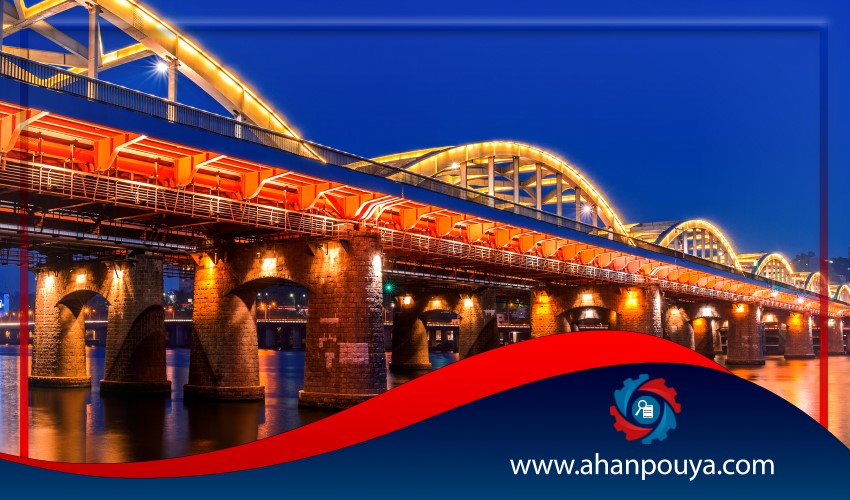
bridge is a structure used to cross the physical barrier including rivers and valleys. Mobile bridges have also been built to allow ships and long boats to pass under them.
These bridges are usually arched, with lattice beams or load-bearing beams And now their use is temporary.
Due to the good compressive strength of stone materials, many arched bridges are made of these materials. Due to the shortage of stone workers and the relatively long time required to prepare materials and execute structures, today the use of these bridges is limited.
In many arched bridges, concrete is now used instead of stone due to its optimum compressive strength.
Depending on the method of execution and the method of concreting, reinforced concrete bridges can be made of different sections and with desired shapes. However , using simple sections to reduce the price of the formwork is always desired . In some cases, using a prefabricated system eliminates mold retaining components and results in significant savings.
With the development of this technique, in a wide range of technical buildings, prestressed concrete bridges have gradually replaced metal bridges and reinforced concrete bridges. In this way, bridges with large spans are built at a lower cost. On the other hand, the use of these materials allows the use of new bridge construction techniques.
These bridges are made in different shapes, with ordinary load-bearing beams or steel mesh beams, with metal arches or molds, rolled from sheets and connecting elements. The construction of these bridges is sometimes used in light or ink alloys. The use of iron in the construction of metal bridges began in the last century and due to the optimal tensile and compressive strength of these materials became widespread. Due to the high cost of production, steel profiles are usually of small thickness and as a result, in addition to the problem of rust and corrosion, there is always a risk of elastic instabilities. On the other hand, as the dead weight of bridges increases rapidly with increasing span length, considering the dimensions and consequently the style of metallic sections , it is still important .
Metal bridge coverings can be selected from reinforced concrete stone materials or metal sheets. the use of wood for coated webs has been common in ancient times , but it is rarely used today . It is also used in new designs to cover stone material due to its excessive weight . In this solution, the longitudinal beams of the bridge are connected by arches of brick and stone materials.
One of these coatings consists of a series of metal plates covered with reinforced concrete and welded to the upper wing of a longitudinal beam. Another common type of metal coating is the orthotropic slab. This coating consists of a metal plate that is reinforced in a vertical direction by simple sheets or boxes. The metal plate acts as the upper wing of the beams and while participating in the flexural strength, it also withstands local loads from the wheels of vehicles.
the metallic gratings can be described as follows :
1.Bridge with metal bar beam
2.Arched bridges
3.Bridge with cable
An arched bridge is a bridge with end supports on each side, which has a semicircular shape. A bridge made up of a series of arches is called a valley bridge . The arch bridge was first built by the Greeks and made of stone. Later, the ancient Romans used mortar in their arched bridges. According to the principles of material strength, the radius of the arch and the dimensions of these bridges are chosen so that the vertical loads become a compressive force along the arch.
In these bridges, the beam rests as a rigid plate on one side on the side bases (backpacks) and two long middle bases and on the other side elastically on diagonal cables. These cables extend along the entire length of the bridge and carry the load to the tall, middle piers The mentioned cables can be placed in two vertical plates and in parallel on both sides of the plate or in the transverse direction and diagonally and along the longitudinal axis of the bridge to be connected to the middle base. Also in some cases it is possible to use a set of cables that are located along the longitudinal axis of the bridge.
In these bridges, too, the beam rests as a rigid plate on the side and middle foundations. Although cable-stayed bridges seem to be looking to the future, their idea has come a long way. The first known design of a cable-stayed bridge is given in a book called "New Machines" - published in 1595 - but the idea dates back to the present century when engineers began to use cable-stayed bridges; Was not welcomed. During World War II, when steel was scarce, the plan to rebuild bombed-out bridges whose foundations were still standing was complete. Although cable-stayed bridges have been built in the United States for some time, the response has been overwhelming.
There is no clear classification for cable ducts. However, they can be distinguished by the number of openings, towers and cables as well as the type of beams. There is a lot of variety in the number and type of towers as well as the number and arrangement of cables. Typical towers are used as single, double, gate or even A-shaped towers. In some cases, only the cables on one side of the tower are attached to the deck and the other side is anchored to a foundation or equal weight.
These bridges are the most common types used for medium spans (up to 250 meters). Bearing beams are usually made in the form of box-shaped metal grids or solid composite beams and will have very limited deformation. Metal nets are usually light, but due to their appearance, they are less used in urban areas.

Ahan Pouya with more than a decade of best-selling experience, adheres to professional and ethical principles in the field of selling and buying at inside and outside the borders of Iran, helping you in the steel industry.